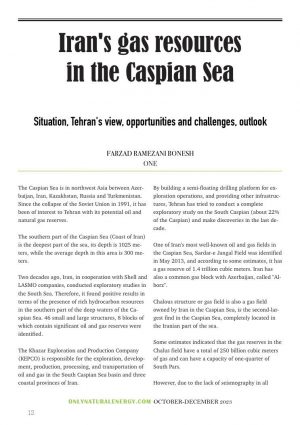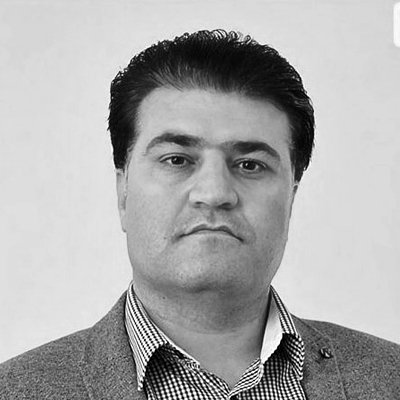 The Caspian Sea is in northwest Asia between Azerbaijan, Iran, Kazakhstan, Russia and Turkmenistan. Since the collapse of the Soviet Union in 1991, it has been of interest to Tehran with its potential oil and natural gas reserves.
The Caspian Sea is in northwest Asia between Azerbaijan, Iran, Kazakhstan, Russia and Turkmenistan. Since the collapse of the Soviet Union in 1991, it has been of interest to Tehran with its potential oil and natural gas reserves.
The southern part of the Caspian Sea (Coast of Iran) is the deepest part of the sea, its depth is 1025 meters, while the average depth in this area is 300 meters.
Two decades ago, Iran, in cooperation with Shell and LASMO companies, conducted exploratory studies in the South Sea. Therefore, it found positive results in terms of the presence of rich hydrocarbon resources in the southern part of the deep waters of the Caspian Sea. 46 small and large structures, 8 blocks of which contain significant oil and gas reserves were identified.
The Khazar Exploration and Production Company (KEPCO) is responsible for the exploration, development, production, processing, and transportation of oil and gas in the South Caspian Sea basin and three coastal provinces of Iran.
By building a semi-floating drilling platform for exploration operations, and providing other infrastructures, Tehran has tried to conduct a complete exploratory study on the South Caspian (about 22% of the Caspian) and make discoveries in the last decade.
One of Iran’s most well-known oil and gas fields in the Caspian Sea, Sardar-e Jangal Field was identified in May 2013, and according to some estimates, it has a gas reserve of 1.4 trillion cubic meters. Iran has also a common gas block with Azerbaijan, called “Alborz”.
Chalous structure or gas field is also a gas field owned by Iran in the Caspian Sea, is the second-largest find in the Caspian Sea, completely located in the Iranian part of the sea.
Some estimates indicated that the gas reserves in the Chalus field have a total of 250 billion cubic meters of gas and can have a capacity of one-quarter of South Pars.
However, due to the lack of seismography in all areas and the unknown depth of the mines, it is impossible to express a reassuring opinion about the accuracy and economy of all sources. But there are also potential reservoirs of Nour, Royan, Ramsar and Rudsar, Gorgan, and other sources.
Tehran’s view
In addition to providing domestic consumption, Iran’s gas strategy has pursued the export of more gas and exploration in the southern basin of the Caspian Sea and the three coastal provinces of Gilan, Golestan, and Mazandaran.
In the past years, Tehran put under consideration measures such as developing a comprehensive strategic plan and prioritizing structures, reviewing and updating information, developing the desired infrastructure for exploration operations, establishing a support base, conducting drilling, increasing regional cooperation with the Caspian Sea border countries in the fields of safety, environmental protection Life, signing several memorandums of understanding with domestic and international HSE-MS companies, and studying the development of Sardar Jangal field and exploratory blocks in South Caspian gas resources.
Also, the National Iranian Oil Company has not set the goal and priority of an immediate deadline for production from Iran’s huge hydrocarbon resources in the Caspian Sea.
The discovery of new reserves in the Caspian Sea, in addition to determining and maintaining the share of hydrocarbon resources, plays a role in improving Iran’s position in terms of hydrocarbon reserves in international forums.
With the special attention of the Iranian government, drilling and gas extraction studies have been underway. It seems that little by little the look at the production sector has also been strengthened.
At the end of December 2023, Petro Iran and KEPCO considered the feasibility study and transfer of hydrocarbons to the surface, checking the amount of gas produced, conducting long-term early production tests in the Sardar Jangal field, and developing priority blocks in the South Caspian basin.
In addition, referring to the principle of fairness and the agreements of 1921 and 1940 and the shape of the Caspian Sea in the south of this sea, Iran has continued negotiations with the countries surrounding the Caspian Sea to access the most rights in the sea.
Tehran also strongly opposes the reduction of its share in the Caspian Sea. In 2001, when Azerbaijan was trying to exploit the Alborz-Alovu field by BP, Iran intervened militarily and prevented the exploitation.
Opportunities and challenges
Apart from the increase in national gas production, Iran exported 18.9 billion cubic meters of natural gas through pipelines in 2023, which is equivalent to 2.5% of the total global natural gas trade in that year.
Tehran plans to develop bilateral and multilateral relations with a focus on gas and in line with Iran’s strategic approach to increase the production and export of natural gas (Iran’s Vision Document) to achieve an 8-10% share of gas trade in the region, Europe and Asia markets by 2025.
Iranian President Ebrahim Raisi said at the March 2024 meeting of the Gas Exporting Countries Assembly in Al Jazeera: “Iran is ready to become an energy pole and a safe route for the distribution and transit of natural gas between producers and consumer markets.
In 2023, Russia and Iran increased energy cooperation, and recently negotiations with Russian companies regarding contracts for the further development of oil and gas fields in Iran have reached the final stage. These contracts probably include Caspian gas resources.
The prospect of developing gas resources in northern Iran is also related to the strategic agreement between Iran and China. China may be willing to liquefy Caspian gas resources.
If the estimates are accurate and the continuation of the exploration of the Chalus structure is successful, it can be compared to the huge oil and gas fields in the south of Iran.
Even though the Turkmen, Azerbaijani, and Iranian sides have emphasized and agreed not to extract oil until their disputes are resolved, and there are negotiations and a general memorandum, there is no definitive agreement about Iran’s share of the resources of the Caspian Sea. Therefore, there is still a long way to the final signing of the Caspian Sea Legal Regime Convention.
The role of the southern Caspian sub-base has not been clarified and it affects the extraction and export of gas in Iran. There are still doubts and disputes over the fields near the border between the countries.
Practically, the effectiveness of signing the Caspian Sea Legal Regime Convention depends on the effectiveness of bilateral negotiations between Tehran-Baku, Tehran-Ashgabad, Baku-Ashgabad, and the agreement between the countries surrounding the Caspian Sea. In addition, Iran’s coasts in the Caspian Sea are deep, and drilling and exploration are not economical and require expensive marine technology. So, despite the lack of financial resources, the costs will multiply.
Lack of connection with open waters, operational limitations related to equipment transportation, changing weather and climate conditions, very difficult support, special geological conditions, environmental risks of the Caspian, high risk of exploration operations, and anti-Iranian sanctions are among the main challenges for the development of gas fields by Tehran.
There are still ambiguities about the certainty of the existence of the reservoir, the estimation of the volume of the reservoir, and other technical and economic components in the southern part of the Caspian, and there is a need for appropriate evaluation studies and development plans. The exploratory excavation in the Chalus structure will take about two years.
Outlook
Iran still has no income from Caspian gas and is the only country whose gas production in this region is zero. Iran’s gas export volume is only 7% of the total domestic consumption.
Neglecting to invest in the development of Caspian gas fields may distance Iran from part of the global gas markets. Also, extensive exploitation of Iran’s gas reserves depends on basic foreign investment and the use of modern technologies.
The Iranian fields of the Caspian Sea can become a new energy center and according to the new geopolitical developments, it has the potential to supply a more important part of the energy needs of Europe and other regions. Caspian gas also is a great opportunity for Iran to exploit its gas reserves and has the potential to increase Iran’s global position and reach the first rank in the global gas market.
Caspian gas can provide an opportunity for Iran to diversify its exports and play a greater role in the energy markets of the region.
Farzad Ramezani Bonesh





